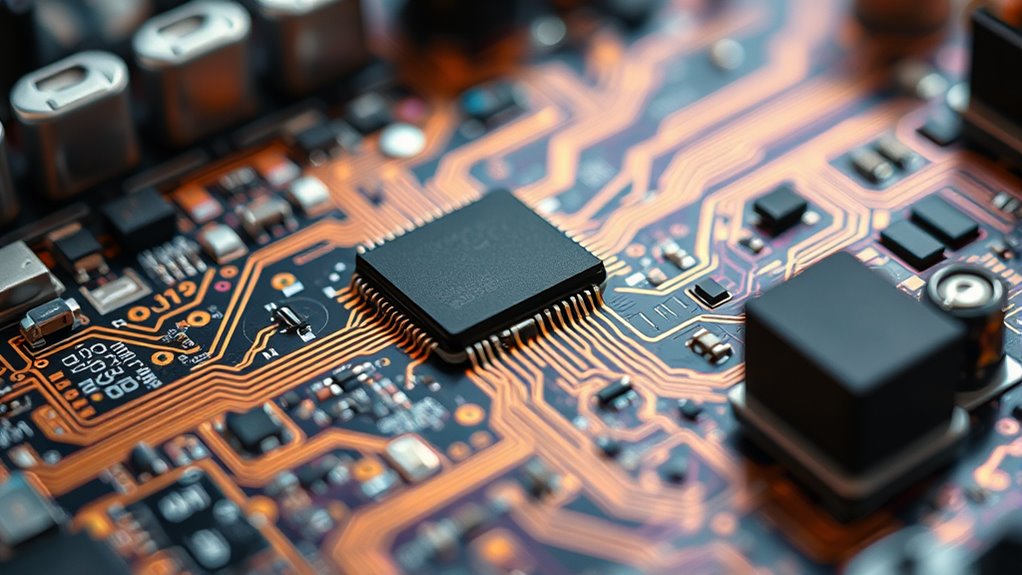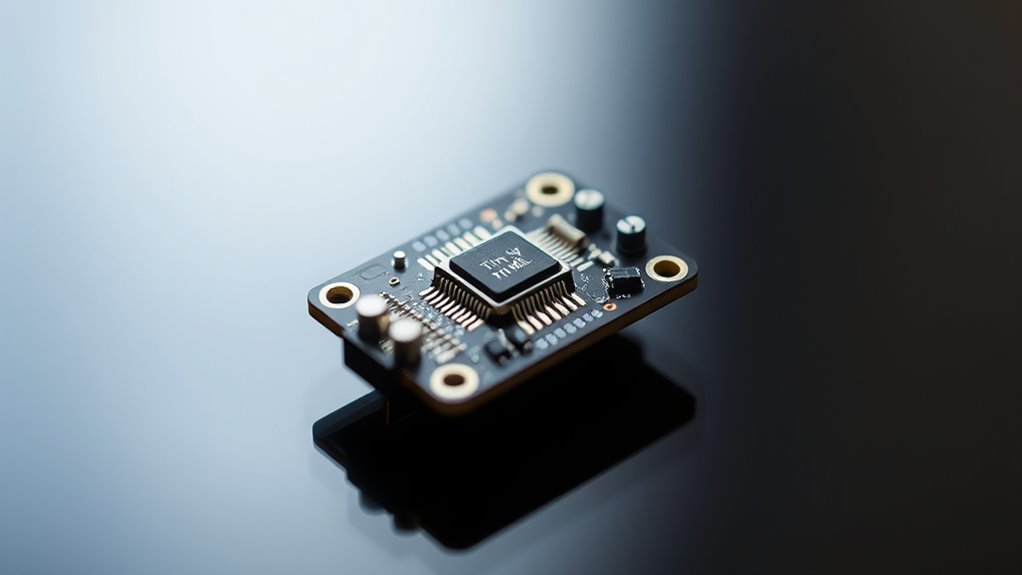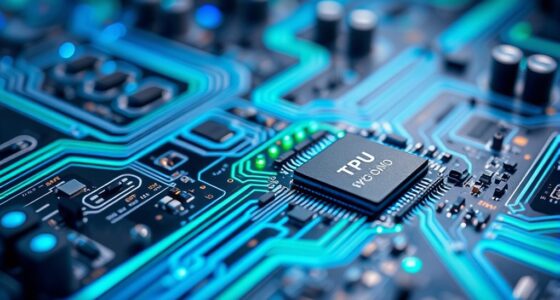TinyML makes it possible for machine learning models to run within just 256 KB on tiny devices. By using techniques like pruning and quantization, you can deploy accurate AI models on limited hardware like sensors and wearables. This approach enables real-time processing, enhances privacy, and reduces reliance on cloud infrastructure. If you keep exploring, you’ll discover how these compact models are transforming smart devices and enabling new possibilities in edge computing.
Key Takeaways
- TinyML enables deploying machine learning models as small as 256 KB on resource-constrained devices.
- Model compression techniques like pruning and quantization help fit complex models into tiny sizes.
- Edge computing allows local data processing, reducing reliance on cloud infrastructure within small memory limits.
- TinyML supports real-time, low-latency decisions on embedded hardware with minimal energy consumption.
- This approach facilitates privacy-preserving, autonomous smart devices capable of running ML models within 256 KB.

Have you ever wondered how tiny devices can perform complex tasks without relying on powerful servers? The secret lies in the innovative field of TinyML, where machine learning models are optimized to run directly on small, resource-constrained devices. Unlike traditional machine learning that depends heavily on cloud infrastructure, TinyML leverages edge computing to bring intelligence closer to the source of data. This approach reduces latency, preserves privacy, and decreases reliance on constant internet connectivity. But achieving this requires more than just deploying standard models; it demands techniques like model compression to fit sophisticated algorithms into tiny footprints—sometimes as small as 256 KB.
TinyML enables complex tasks on small devices through model compression and edge computing, reducing latency and preserving privacy.
Edge computing forms the backbone of TinyML, allowing processing to happen right on the device itself. When you’re dealing with sensors, wearables, or IoT gadgets, sending data back and forth to the cloud isn’t always feasible or efficient. Instead, models must be lightweight enough to operate locally, making real-time decisions without delay. That’s where model compression comes into play. By pruning unnecessary parameters, quantizing weights, or applying other compression techniques, developers can considerably shrink models while maintaining their accuracy. This process ensures that complex tasks—like image recognition, voice commands, or anomaly detection—can be performed on devices with minimal memory and processing power.
You might think that reducing a model’s size would compromise its effectiveness, but with clever compression strategies, you can retain high performance. For example, quantization reduces the precision of weights from 32-bit floats to 8-bit integers, cutting down memory usage and computational requirements. Pruning removes redundant connections in neural networks, further slimming down the model without sacrificing accuracy. The result is a lean, efficient model that can operate seamlessly within tight constraints, enabling devices to make intelligent decisions locally. Additionally, understanding the importance of model evaluation ensures that compressed models remain reliable and effective in real-world scenarios.
This convergence of edge computing and model compression makes TinyML a game-changer. It empowers you to develop hardware that’s not only small and energy-efficient but also capable of intelligent processing. Whether it’s a smart camera detecting faces, a wearable health monitor analyzing vital signs in real-time, or a sensor detecting environmental changes, TinyML enables these devices to act autonomously. You no longer need bulky hardware or constant cloud connectivity to harness the power of machine learning; instead, you optimize models to fit tiny footprints and shift computation to the edge. This revolution makes smart devices more accessible, responsive, and private, opening new possibilities for innovation across industries.
Frequently Asked Questions
How Does Tinyml Compare to Traditional Machine Learning in Accuracy?
You might wonder how model accuracy compares when working with data constraints. TinyML models often have slightly lower accuracy than traditional machine learning models because they operate within strict size limits. However, with optimized algorithms and feature selection, you can still achieve reliable results. While TinyML may sacrifice some precision, it’s ideal for applications needing low power, real-time responses, and on-device processing where traditional models might be too bulky.
What Are the Most Common Applications of Tinyml Today?
You’ll find TinyML most commonly used in edge AI applications like smart sensors, wearables, and IoT devices. It enables real-time data processing directly on devices, which helps preserve privacy by keeping data local. This means you can deploy machine learning models in small devices without needing constant cloud connection, making applications more efficient, private, and responsive. TinyML’s popularity grows as more devices require privacy-preserving, on-device AI solutions.
Can Tinyml Be Integrated With Existing Iot Devices Seamlessly?
You can seamlessly integrate TinyML with existing IoT devices by leveraging its edge computing capabilities, which process data locally instead of sending it to the cloud. This not only reduces latency but also enhances data privacy, keeping sensitive information secure. By deploying lightweight models, your devices become smarter without extra hardware, making the integration smooth and efficient, ensuring your IoT ecosystem remains responsive and secure.
What Hardware Platforms Are Ideal for Tinyml Deployments?
Think of edge computing as your device’s brain, making decisions at the source. For tinyML deployments, hardware like the ARM Cortex-M series, RISC-V chips, and specialized microcontrollers excel. They efficiently handle embedded sensors and process data locally, reducing latency and conserving bandwidth. These platforms are compact, low-power, and perfect for integrating machine learning into your IoT devices seamlessly, ensuring real-time insights without relying on cloud connectivity.
How Do Power Consumption and Efficiency Impact Tinyml Performance?
Power consumption and efficiency directly impact your machine learning performance, especially in resource-constrained environments. By focusing on energy efficiency and power optimization, you guarantee your models run longer on limited power sources like batteries. Reduced power use not only prolongs device lifespan but also minimizes heat, improving reliability. Ultimately, optimizing power consumption helps you achieve faster, more efficient TinyML deployments, making your applications more sustainable and effective.
Conclusion
You might be surprised that TinyML models can run on just 256 KB of memory, yet they deliver impressive results. Imagine deploying machine learning directly on tiny devices, like wearables or sensors, without relying on the cloud. This approach reduces latency and preserves privacy. With over 60% of data generated on devices, TinyML is transforming how we think about AI’s reach, proving that big intelligence can fit in the smallest spaces.









